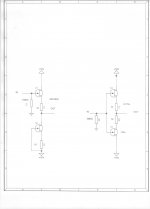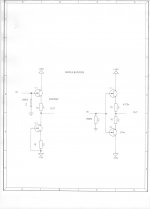Hi John, I'm waiting for the components (capacitors and diodes) to arrive. They are due on the next few days. Upon replacing the capacitors and diodes I'll see if there is still noise from the MC pre stage. If yes, I'll try to pinpoint the noisy components and replace them. In any case I'll report here the progress and results.
It is a trivial circuit, right?
Indeed, a trivial one, yet beautifully designed and the overall phono stage sounds excellent.
I meant trivial to repair.
It should be, unless it will turn out that some JFETs are causing noise and I will not be successful in pinpointing which one(s) with a freeze spray. It is yet to be seen. On the worst case, I'll replace all JFETs, which isn't very difficult, only a waste and matching JFETs is time consuming…
First things first, Joshua. Clean the board, and test again. Also, inspect the caps, are they physically damaged?
Hi John, thank you.
As I wrote previously, I'm going to replace all electrolytic capacitors, both in the PSU and all over the preamp. For a 20 years old preamp, I'm not waiting to see any physical damage, those electrolytics are due replacing.
Also, on your modules, after thorough cleaning the PCBs, I'm going to replace all the polystyrene caps, without looking for physical damage.
Then we'll see if the noise will be gone.
I only replied Pavel's comment about the triviality of repairing those modules. It may be trivial, as it may turn out not so trivial. Time will tell. I'm not hurrying anywhere…
As I wrote previously, I'm going to replace all electrolytic capacitors, both in the PSU and all over the preamp. For a 20 years old preamp, I'm not waiting to see any physical damage, those electrolytics are due replacing.
Also, on your modules, after thorough cleaning the PCBs, I'm going to replace all the polystyrene caps, without looking for physical damage.
Then we'll see if the noise will be gone.
I only replied Pavel's comment about the triviality of repairing those modules. It may be trivial, as it may turn out not so trivial. Time will tell. I'm not hurrying anywhere…
Update
After replacing all the relevant capacitors, the crackling noise is gone. So no JFET is damaged.
I adjusted the offset voltage, after 30 minutes of operation, to 0 +/- 3mV.
Alas, on my ZYX cartridge (a $3,000 one), one of the coils is open. I sent it via the local dealer to ZYX Japan for repair cost quote. Will see if I can afford the repair. Meanwhile I purchased Denon DL-103R cartridge (a $300 one). It should be here within a week or so. Then I hope to enjoy some music again.
After replacing all the relevant capacitors, the crackling noise is gone. So no JFET is damaged.
I adjusted the offset voltage, after 30 minutes of operation, to 0 +/- 3mV.
Alas, on my ZYX cartridge (a $3,000 one), one of the coils is open. I sent it via the local dealer to ZYX Japan for repair cost quote. Will see if I can afford the repair. Meanwhile I purchased Denon DL-103R cartridge (a $300 one). It should be here within a week or so. Then I hope to enjoy some music again.
great news that none of the rare jfets were damaged, at least you dodged the bullet on that one.
🙂
i know the caps were old so replacing the electrolytics and cleaning the board was a good bet. just curious if you were able to determine if one particular cap was the primary source of the symptoms? and if you looked at any of the caps with an ESR meter?
did you also replace the poly caps? similar to the earlier comments about small likelihood of the jfets failing, i'd be surprised if the film caps were guilty.
mlloyd1
🙂
i know the caps were old so replacing the electrolytics and cleaning the board was a good bet. just curious if you were able to determine if one particular cap was the primary source of the symptoms? and if you looked at any of the caps with an ESR meter?
did you also replace the poly caps? similar to the earlier comments about small likelihood of the jfets failing, i'd be surprised if the film caps were guilty.
mlloyd1
Hi,
Thank you.
I replaced all electrolytic caps in the PSU and in the amp and the polystyrene caps in the MC modules.
I didn't bother to check individual caps, the old ones are long gone with the trash. I'm into the practical solution, not into a case study… Since the caps were bought and paid for, I just replaced them all. I don't care which ones of them are to blame, as long as it works properly.
Thank you.
I replaced all electrolytic caps in the PSU and in the amp and the polystyrene caps in the MC modules.
I didn't bother to check individual caps, the old ones are long gone with the trash. I'm into the practical solution, not into a case study… Since the caps were bought and paid for, I just replaced them all. I don't care which ones of them are to blame, as long as it works properly.
Well, you got it fixed with a minimum amount of extra trouble. I'm glad.
The potential need to replace a matched pair of discontinued devices was daunting.
The potential need to replace a matched pair of discontinued devices was daunting.
Buffer questions
Thanks, John.
If I may ask you some other questions, concerning buffers.
I purchased a double autoformer mounted on a proper selector (IVC – Inductive Volume Control) to be used as passive preamp.
I connected it to my power. The purity and quality of the sound were superb, like I never heard before on any sound setup (I wasn't fortunate to hear your CTC Blowtorch). Alas, the dynamics of the sound is gone. Since the input impedance of my power amp is 20 KOhm (Pass Labs XA 30.5), I thought that the low input impedance of the power amp may be to blame.
So I connected the output of the IVC to one of the inputs of my preamp, which has a tape out buffer, probably designed by you, and connected the tape out to the input of my power amp. Not only the dynamics is back again, actually it's much better than ever before, along with all other SQ benefits.
So I intend to build a JFET buffer to replace the preamp.
Sorting out my storage I found out that I have over 100 pieced of 2SK170V, 100 pieces 2SJ74V and similar quantities of BL and GR grades.
Here come my questions:
1. The present buffer uses 1 x 2SK389 per channel. I can use a couple of 2SK170 per channel thermally coupled. However, wouldn't there be any SQ improvement by using a complementary pair of 2SK170 / 2SJ74 per channel?
2. In either case, would there be any benefit in cascoding the initial pair?
3. In either case, would there be a benefit by using higher supply voltages, about -24V and somewhat less positive?
4. The buffer supply voltages are generated by Zeners, decoupled by film capacitor. Would there be any benefit by using better supply smoothing, like capacitance multiplier or even Jung's Super Regulator?
You see, my setup sounds so superb by having he buffer between the IVC and power amp, that I want the best possible good sounding buffer.
Thank you.
Thanks, John.
If I may ask you some other questions, concerning buffers.
I purchased a double autoformer mounted on a proper selector (IVC – Inductive Volume Control) to be used as passive preamp.
I connected it to my power. The purity and quality of the sound were superb, like I never heard before on any sound setup (I wasn't fortunate to hear your CTC Blowtorch). Alas, the dynamics of the sound is gone. Since the input impedance of my power amp is 20 KOhm (Pass Labs XA 30.5), I thought that the low input impedance of the power amp may be to blame.
So I connected the output of the IVC to one of the inputs of my preamp, which has a tape out buffer, probably designed by you, and connected the tape out to the input of my power amp. Not only the dynamics is back again, actually it's much better than ever before, along with all other SQ benefits.
So I intend to build a JFET buffer to replace the preamp.
Sorting out my storage I found out that I have over 100 pieced of 2SK170V, 100 pieces 2SJ74V and similar quantities of BL and GR grades.
Here come my questions:
1. The present buffer uses 1 x 2SK389 per channel. I can use a couple of 2SK170 per channel thermally coupled. However, wouldn't there be any SQ improvement by using a complementary pair of 2SK170 / 2SJ74 per channel?
2. In either case, would there be any benefit in cascoding the initial pair?
3. In either case, would there be a benefit by using higher supply voltages, about -24V and somewhat less positive?
4. The buffer supply voltages are generated by Zeners, decoupled by film capacitor. Would there be any benefit by using better supply smoothing, like capacitance multiplier or even Jung's Super Regulator?
You see, my setup sounds so superb by having he buffer between the IVC and power amp, that I want the best possible good sounding buffer.
Thank you.
Joshua, that is a lot of questions.
It is possible to make a pretty darn good buffer, either by using a matched dual device, like the 2SK389, or with a complementary matched pair, that can be tweaked for low DC offset. More to follow.
It is possible to make a pretty darn good buffer, either by using a matched dual device, like the 2SK389, or with a complementary matched pair, that can be tweaked for low DC offset. More to follow.
Hi John,
Thank you.
I'm eager to hear more.
Please bear in mind that I'm looking here for the best possible buffer.
I'm interested in your views as for the advised topology, or topologies, no need for detailed schematics.
When using complementary pair, I can manage to get negligible DC offset. It can be done by adjusting the (+) and/or (-) supply voltage(s), and/or by trimming one, or both, source resistor(s). Servo wouldn't be necessary here.
Thank you.
I'm eager to hear more.
Please bear in mind that I'm looking here for the best possible buffer.
I'm interested in your views as for the advised topology, or topologies, no need for detailed schematics.
When using complementary pair, I can manage to get negligible DC offset. It can be done by adjusting the (+) and/or (-) supply voltage(s), and/or by trimming one, or both, source resistor(s). Servo wouldn't be necessary here.
- Status
- Not open for further replies.
- Home
- Source & Line
- Analogue Source
- JFETs replacing and matching questions

